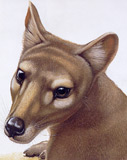Gap in Nature
Air Date: Week of August 13, 2004
As part of our occasional series “A Gap in Nature,” author Tim Flannery chronicles the rise and fall of a marsupial hunter called the thylacine.
Transcript
CURWOOD: These days, we don’t think of marsupials, such as kangaroos and koala bears, as predators. But hunters did once exist among the marsupials, and the largest of these animals to have survived into modern times was the thylacine. As part of our continuing series, “A Gap in Nature,” author Tim Flannery chronicles the rise and fall of this rather strange creature from down under.
[MUSIC: Junior Communist Club “Ultrabollywood” Freedom of Speed Sugar Free (1999)]
 (Illustration by Peter Schouten)
(Illustration by Peter Schouten)
In either case, the thylacine dispatched its victim by crushing its skull in jaws that could open remarkably wide. As for those who hunted the thylacine, Aborigines occasionally pursued them, but seem to have held them in respect. They built a curious shelter over the thylacines’ bones in the belief that if they were rained upon, bad weather was certain to follow. But it was European settlers who relentlessly persecuted the thylacine into extinction, since sheep farmers saw them as a threat. So a bounty was paid on thylacine scalps. As live animals became increasingly rare, dead ones commanded ever higher prices.
In a move that was far too little, too late, the species was finally protected by the Australian government in 1936, the year that the last known living individual died. That animal was a lone female thylacine kept in the Tasmanian Zoo. When personnel problems developed there, the zoo animals were neglected. As one witness put it, the last thylacine was left exposed by staying out in an open, wire-topped cage with no access to a sheltered den. In September that year, daytime temperatures soared above 100 degrees while at night they plummeted to below freezing. On September seventh, the stress became too much for the last thylacine and, unattended by her keepers, she closed her eyes on the world for the last time.
However, it’s possible that a few wild individuals roamed the island for a decade or two after this, for there were a few credible sightings into at least the 1940s. One old hunter said that he found a female and three cubs in an area that was later flooded to create a hydroelectric power plant. When pressed on whether his dogs had killed the thylacines, the hunter dodged the issue but it’s thought they probably did. Now all hope is lost for, although many expensive searches have been made, no thylacine sightings have been authenticated for many years. Some hope to recreate the thylacine from DNA taken from museum specimens. But given our knowledge of molecular biology, this is just a pipe dream.
CURWOOD: Tim Flannery is author of “A Gap in Nature: Discovering the World’s Extinct Animals.” To see a picture of the last thylacine and to hear other segments in our series go to our website, livingonearth.org. That’s livingonearth.org…Just ahead, a new way to grow trees. Stay tuned to Living on Earth.
ANNOUNCER: Support for NPR comes from NPR stations and the Noyes Foundation dedicated to improving math and science instruction from kindergarten through grade 12. Ford, presenting the Escape hybrid whose full hybrid technology allows it to run on gas or electric power. Full Ford technology details at vehicles at fordvehicles.com. The Annenberg fund for excellence in communications and education and the Kellogg Foundation, helping people help themselves by investing in individuals, their families, and their communities. On the web at wkkf.org. This NPR, National Public Radio.
[MUSIC BREAK]
Living on Earth wants to hear from you!
Living on Earth
62 Calef Highway, Suite 212
Lee, NH 03861
Telephone: 617-287-4121
E-mail: comments@loe.org
Newsletter [Click here]
Donate to Living on Earth!
Living on Earth is an independent media program and relies entirely on contributions from listeners and institutions supporting public service. Please donate now to preserve an independent environmental voice.
NewsletterLiving on Earth offers a weekly delivery of the show's rundown to your mailbox. Sign up for our newsletter today!
 Sailors For The Sea: Be the change you want to sea.
Sailors For The Sea: Be the change you want to sea.
 The Grantham Foundation for the Protection of the Environment: Committed to protecting and improving the health of the global environment.
The Grantham Foundation for the Protection of the Environment: Committed to protecting and improving the health of the global environment.
 Contribute to Living on Earth and receive, as our gift to you, an archival print of one of Mark Seth Lender's extraordinary wildlife photographs. Follow the link to see Mark's current collection of photographs.
Contribute to Living on Earth and receive, as our gift to you, an archival print of one of Mark Seth Lender's extraordinary wildlife photographs. Follow the link to see Mark's current collection of photographs.
 Buy a signed copy of Mark Seth Lender's book Smeagull the Seagull & support Living on Earth
Buy a signed copy of Mark Seth Lender's book Smeagull the Seagull & support Living on Earth

